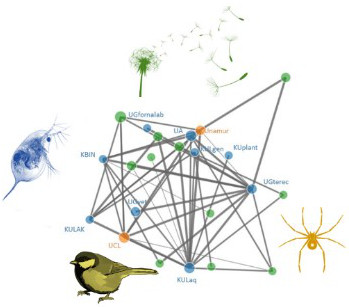 |
Joint symposium on |
|
| Home | Program - EVENET - FAME | Abstracts - EVENET - FAME | Download | Registration | Venue | Committees |
FAME Abstracts
Illuminating the soil black box to unlock its potential
GERLINDE DE DEYN Soils host a tremendous biodiversity which governs functions essential for sustaining plant productivity and diversity. Decomposers in the soil ensure the release of plant growth-limiting mineral nutrients, and mutualistic symbionts can facilitate nutrient acquisition, while plant pathogens reduce plant growth. Different plant species develop different soil communities in their rhizosphere and thereby develop plant-species specific plant-soil feedback (PSF) effects that selectively suppress or stimulate the growth of specific plant species. To date, it remains hard to predict PSF effects, yet it is expected that soil biota respond to plant traits such that plant traits can be indicative for the PSF a plant develops. The development of negative PSF appears to be most common so that plant species combinations in space or time could promote plant productivity via the release of negative PSF. In this presentation I will dig into the mechanisms of PSF and its application in both fundamental and applied ecological research .
How do genomes diverge during adaptive radiations?
CHRIS JIGGINS We are increasingly able to study evolutionary processes such as adaptation and speciation on a genomic scale. I will outline our work to assemble chromosomal-level assemblies of butterfly genomes using high resolution linkage maps. These have been used to study patterns of divergence between closely related species. One of the most pervasive patterns is the extent to which distinct species show a signature of admixture due to hybridisation, which can influence up to 40% of the genome. This hybridisation can also occasionally contribute adaptive variants, and our work has demonstrated the importance of introgression in the origins of complex wing patterns. Genome sequence data from 100s of individuals across two major radiations has identified narrow regions associated with distinct colour pattern elements. We hypothesise that these modules in non-coding sequence represent distinct cis-regulatory loci that control expression of just 3-4 key genes, including the transcription factor optix and the morphogen WntA, which in turn control pattern variation across Heliconius. Phylogenetic analysis of these elements demonstrated that they have distinct evolutionary histories and that novel adaptive morphological variation was created by shuffling these cis-regulatory modules through recombination between divergent lineages. In addition, recombination of modules into different combinations within species further contributes to diversity. Analysis of the timing of diversification supports the hypothesis of introgression moving regulatory modules between species, rather than shared ancestral variation, as divergence can be much younger at wing pattern loci relative to species divergence. I therefore argue that shuffling of existing enhancer elements both within and between species provides a mechanism for rapid diversification and generation of novel morphological combinations during adaptive radiation.
Improving the forecast for biodiversity under climate change
MARC URBAN New biological models are incorporating the realistic processes underlying biological responses to climate change and other human-caused disturbances. However, these more realistic models require detailed information, which is lacking for most species on Earth. Current monitoring efforts mainly document changes in biodiversity, rather than collecting the mechanistic data needed to predict future changes. We describe and prioritize the biological information needed to inform more realistic projections of speciesí responses to climate change. We also highlight how trait-based approaches and adaptive modeling can leverage sparse data to make broader predictions. We outline a global effort to collect the data necessary to better understand, anticipate, and reduce the damaging effects of climate change on biodiversity.
Biological success in the Anthropocene: find the way out of the forest
HANS VAN DYCK Forest and grassland could represent alternative stable states, implying critical transitions of tipping points to altered climate. However, extensive, human-induced land transformations interfere with these natural dynamics as these transformations have globally resulted in significant deforestation and in the creation of different types of grassland. At a smaller scale, the opposite transition from abandoned grassland to shrub and woodland occurs as well. In a wide range of taxonomic groups, typical forest and non-forest species, subspecies and ecotypes have been described. Forest conditions represent on average more humid, cooler and better buffered climatic conditions than do open vegetation types. Although natural forest-grassland dynamics have shaped alternative forest and non-forest life forms, I wonder to what extent human-induced transitions may result in similar tendencies by convergent evolution. I will particularly address a recent case of niche expansion and, consequently range filling, in the Speckled wood (Pararge aegeria L.). Over the last few decades, this butterfly expanded from woodland to warmer habitat in agricultural and urban landscape. Common garden experiments and reciprocal transplant experiments have pointed to several adaptive differences between populations of woodland and agricultural landscape origin. Differences include functional morphology, physiology, behaviour, life-history traits and sensory ecology. Moving both the ancestral and novel ecotype poleward and between forest and agricultural land showed different performances and different levels of phenotypic plasticity in their response, congruent with the view of a habitat specialist and a habitat generalist within the same species. I will discuss what this may signify for the range dynamics of a successful species in an environment under rapid change. |


